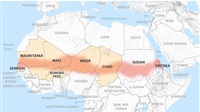The world will end on Sunday according to reading of Mayan calendar

The world will end in less than a week, according to a
reading of the Mayan calendar.
The global coronavirus pandemic, social unrest, geopolitical
tensions, aviation disasters in Iran and Pakistan, and natural disasters in
Australia and the Philippines have combined to make 2020 many people’s worst
year of their lives.
And just when it looked like things couldn’t get any worse,
one interpretation of the Mayan calendar puts the end of the world on June 21,
2020 – this Sunday.
The Mayan calendar is an alternative system of counting time
to the Gregorian calendar, which is used by most people in the world, and other
systems such as the Islamic or Julian calendars.
The calendar was devised by the Maya civilization, a term
which refers to the peoples who inhabited the Central American area of
modern-day Guatemala and Belize, southeast Mexico, and western Honduras and El
Savador before the arrival of European colonialists.
While Europeans conquered the Maya and destroyed most
evidence of their history, in the 1990s archaeologists began to piece together
more knowledge about the civilization’s calendar system.
Unlike the Gregorian or Islamic calendars, the Maya calendar
was not based on cycles of the moon or the sun directly. Instead, they had
three calendars for different purposes.
The Maya long-count calendar is the one that has attracted
attention from Doomsday theorists – people who believe in a catastrophic end to
all life on Earth. According to their reading of the calendar and
interpretation of the Maya belief in “world ages,” the calendar said that the
world was set to end on December, 2012, the date which marked the end of a
5,126-year-long cycle.
While their prediction was evidently wrong, last week a
scientist accused of being a conspiracy theorist reexamined the calendar – and
suggested that the correct date for the end of the world was in fact this week.
Paolo Tagalogun, described online as both a scientist and
conspiracy theorist, made the prediction in a series of tweets last week.
His revision is based on comparing the Maya calendar against
the Julian calendar, which was the prominent calendar used in the Roman world,
most of Europe, and European colonies until it was eventually replaced by
today’s Gregorian calendar from 1582 onwards.
“Following the Julian Calendar, we are technically in 2012 …
The number of days lost in a year due to the shift into Gregorian Calendar is
11 days… For 268 years using the Gregorian Calendar (1752-2020) times 11 days =
2,948 days. 2,948 days/365 days (per year) = 8 years,” said Tagaloguin in a
now-deleted tweet, as quoted by media.
This eight-year difference apparently shifts the end of the
world from 2012 to 2020, and from December 12 to June 21.
However, many experts are wary of using the Maya calendar to
calculate the end of the world, regardless of the date.
Rather than the end of the world, the end of the long-count
calendar represents only the end of an era, according to Emiliano Gallaga
Murrieta, the Chiapas state division director of Mexico’s National Institute of
Anthropology and History, who was interviewed by National Geographic.
“It is like for the Chinese, this is the Year of the
[Rabbit], and the next year is going to the Year of the Dragon, and the next is
going to be another animal in the calendar,” Gallaga said.
As of Monday, no world leaders have commented on the
supposed imminent catastrophe.







